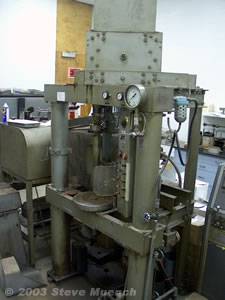Hveem Method
HDOT uses the Hveem method of HMA mixture design. Like the Marshall and Superpave methods, the Hveem method has been proven to produce quality HMA from which long-lasting pavements can be constructed. This section briefly discusses the Hveem mix design method.
 |
 |
| Figures 1 and 2: HDOT's California Kneading Compactor. | |
The basic concepts of the Hveem mix design method were originally developed by Francis Hveem when he was a Resident Engineer for the California Division of Highways in the late 1920s and 1930s.
| HAPI Pavement Note on Hveem Mix Design |
The HDOT materials laboratory on O'ahu is the only laboratory in Hawai'i equipped with Hveem mix design equipment (California Kneading Compactor - see Figures 1 and 2, and the Hveem stabilometer and cohesiometer). |
As done by HDOT, the Hveem mix design method
consists of three basic steps:
- Aggregate selection. Different agencies/owners specify different methods of aggregate acceptance. Typically, a battery of aggregate physical tests is run periodically on each particular aggregate source. Then, for each mix design, gradation and size requirements are checked. Normally, aggregate from more than one source is required to meet gradation requirements.
- Asphalt binder selection. HDOT uses the the Superpave PG system. Hawai'i's common asphalt binder grade is a PG 64-16.
- Optimum asphalt binder content determination. In the Hveem method, this step can be broken up into 5 substeps:
- Prepare multiple initial samples, each at a different asphalt binder content. For instance, one sample each might be made at 4.5, 5.0, 5.5, 6.0, 6.5 and 7 percent asphalt by dry weight for a total of six samples.
- Compact these trial mixes in the California Kneading Compactor (see Figures 1 and 2). This compactor is specific to the Hveem mix design method.
- Test the samples for stability and cohesion using the Hveem stabilometer and cohesiometer. These tests are specific to the Hveem mix design method. Passing values of stability and cohesion depend upon the mix class being evaluated. Typically, all samples pass the cohesion test and three or four pass the stability test.
- Determine the density and other volumetric properties of the samples.
- Select the optimum asphalt binder content. The asphalt binder content corresponding to 4 percent air voids is selected as long as this binder content passes stability and cohesion requirements.
Basic HDOT Hveem mix design specifications from the HDOT 1994 Standard Specifications for Road, Bridge and Public Works Construction are shown in Tables 1 and 2 below. These tables do not list all specifications.
Table 1: Basic HDOT Hveem Mix Design Specifications
Item |
Specification |
Minimum Stability |
37 |
Maximum Swell |
0.030 inches |
Air Voids |
3 - 5% |
Table 2: Basic HDOT VMA Specifications for Hveem Mix Designs
Nominal Maximum Aggregate Size (inches) |
1.5 |
1.0 |
0.75 |
0.50 |
0.375 |
VMA (percent) |
11 |
12 |
13 |
14 |
15 |


